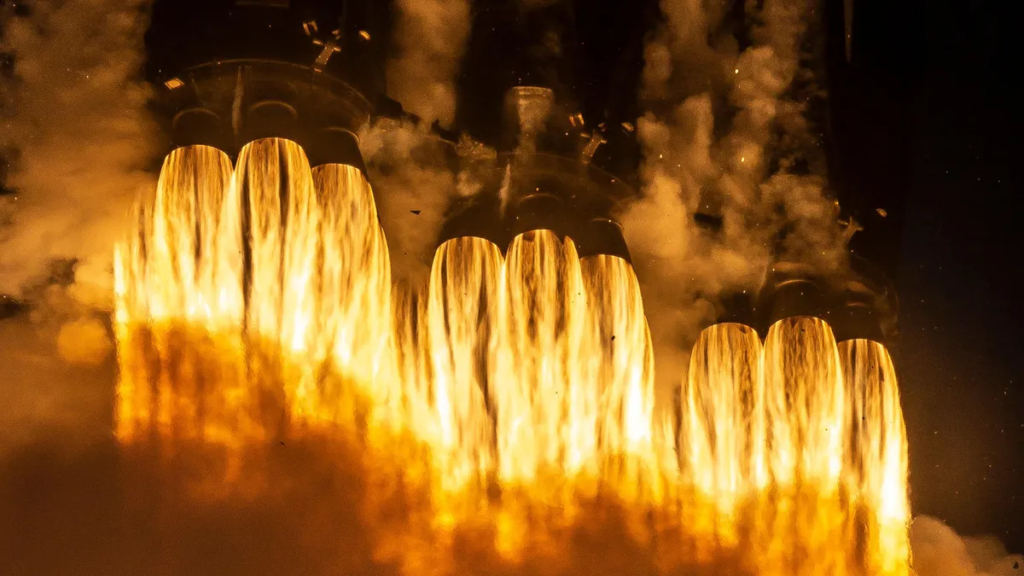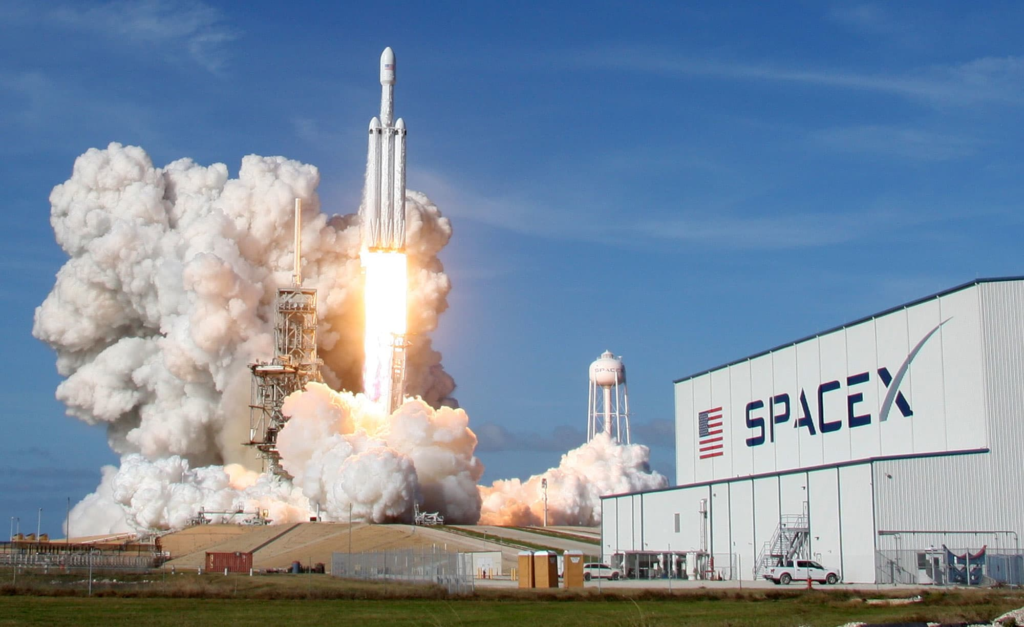
Falcon Heavy’s Next Launch Is Only Months Away
After years without a launch, SpaceX’s Falcon Heavy has come back with a full schedule of unique missions. Since November of last year, we have already watched the heavy-lift rocket lift off two times, both with successful results. Now in February, the company is preparing for another launch just over a month away.
As of right now, Falcon Heavy’s next mission is scheduled to happen in early April with Viasat. This launch features a special mission profile and a long coast phase in between burns for the upper stage. Not to mention a very big primary payload and secondary payload from Arcturus. All of which is the reason why SpaceX and the Falcon Heavy were picked as the launch provider and vehicle.
In the past couple of years, a partial lack of demand, the success of the Falcon 9, and various delays, all put the Falcon Heavy on the back burner and led to its dormant period. Thankfully that period is over and a record number of launches are set to happen this year alone for the rocket. Here I will go more in-depth into this upcoming mission, the special mission profile, what to expect in the coming weeks, and more.
Next Mission

Different reports suggest that Saturday, April 8th, 2023 Falcon Heavy will launch the Viasat-3 satellite. Falcon Heavy was originally slated to launch the Viasat-2 satellite, but due to delays an Ariane 5 launch vehicle was used instead. There have been a few delays relating to this launch that have to do with Viasat. Late last year, Viasat CEO Mark Dankberg said, ViaSat-3’s deployable subsystems are currently being inspected and reintegrated into launch configuration following successful environmental and ground tests. He also commented that Viasat is working with SpaceX to target a launch in the “earlier part of the quarter,” but this depends on the timing of “some U.S. national priority launches” using the same Falcon Heavy launchpad.
After the Ariane 5 replacement, Viasat maintained the launch option and will launch its next Ka-band satellite, which will serve either the Asia-Pacific (APAC), Europe, Middle East and Africa, or Americas regions, using Falcon Heavy. ViaSat-3 is planned to be a global satellite constellation consisting of three high-capacity Ka-band satellites that are expected to increase the coverage and capacity of our network to bring high-quality, low-cost connectivity where it’s needed most. Not long ago, the ViaSat-3 satellite entered the mechanical environmental testing process, simulating the vibration and acoustic environments that the satellite will experience during the launch and early transfer orbit phases of its mission. By now, the first ViaSat-3 payload module is finished and delivered to Boeing for completion of the satellite and testing.
Focusing on the mission profile, the upper stage of Falcon Heavy will deploy the satellite into a near-geosynchronous orbit that will include a coasting stage several hours long between burns. In the last few Falcon Heavy missions, there has been a similar coast phase between burns. In both these examples you could see a large gray band on the upper stage of the rocket. Specifically, the second stage featured a gray band to allow more heat from sunlight to be absorbed to warm the RP-1 kerosene tank during the longer coasting period. On the USSF-44 mission, this was a first for Falcon Heavy and the third for any Falcon rocket. When it gets too cold, kerosene – which freezes at a much higher temperature than Falcon’s liquid oxygen oxidizer – becomes viscous and slush-like before it freezes solid. If ingested, slushy fuel would likely prevent ignition or destroy the upper stage’s Merlin engine. Based on the past missions and their results, it seems like this strategy has worked well for the company and we can expect another gray band on this upcoming mission.
In addition to the main payload, Arcturus was added as an independent secondary payload in late September 2021. Arcturus is a telecommunications satellite built and operated by Astranis Space Technologies with capacity leased exclusively to Pacific Dataport. The spacecraft will provide high speed internet to remote areas in Alaska. Both payloads combined are expected to weigh around 6,700kg in total. In terms of recovery. It will also feature an expendable center core with no grid fins or landing gear. The other two side boosters however will be targeting a landing back near the launch site.
Falcon Heavy

Now that we know more about this upcoming mission and what to expect, we can take a closer look at the other missions planned for 2023 and the innovative design of Falcon Heavy. Besides the Viasat mission scheduled in April, there are at least another 3 missions expected to happen in 2023. This includes USSF-52, Jupiter 3, and NASA’s Psyche.
When looking at the rocket’s past and upcoming missions, you can see a common theme which includes a lot of government launches. Back in April 2015, SpaceX sent the U.S. Air Force an updated letter of intent outlining a certification process for its Falcon Heavy rocket to launch national security satellites. The process included three successful flights of the Falcon Heavy including two consecutive successful flights, and the letter stated that Falcon Heavy can be ready to fly national security payloads by 2017. However, in July 2017, SpaceX announced that the first test flight would take place in December 2017, pushing the launch of the second launch (Space Test Program 2) to June 2018. In May 2018, on the occasion of the first launch of the Falcon 9 Block 5 variant, a further delay to October 2018 was announced, and the launch was eventually pushed back to 25 June 2019. The STP-2 mission used three Block 5 cores. SpaceX was awarded 40% of the launches in Phase 2 of the National Security Space Launch (NSSL) contracts, which includes several launches and a vertical integration facility, and the development of a larger fairing, from 2024 to 2027.
The other main customer has been NASA. For example, Falcon Heavy is the launch vehicle for the initial modules of the Lunar Gateway: Power and Propulsion Element (PPE) and Habitation and Logistics Outpost (HALO). To decrease complexity NASA announced in February 2021 that it is launching the first two elements on a single Falcon Heavy launch vehicle, targeting a launch date no earlier than November 2024. Before switching to a merged launch, NASA listed in April 2020 Falcon Heavy as the launch vehicle for PPE lone launch. Before then, Falcon Heavy won the first award for a resupply mission to the Gateway, placing a new Dragon XL spacecraft on a translunar injection orbit.
Lastly, NASA chose Falcon Heavy as the launch vehicle for its Psyche mission to a metallic asteroid with a planned launch in October 2023. The contract is worth US$117 million. Europa Clipper was initially targeted to be launched on an SLS rocket. However, due to extensive delays, in 2021 NASA awarded the launch contract to SpaceX for a fully expendable Falcon Heavy. All of which we can look forward to in the coming months and years. In all likelihood, this schedule will only get busier as time goes on.
All of these missions point out that the Falcon Heavy is quite special and has a prominent place within the industry. Most of which has to do with its design and purpose. With more than 5 million pounds of thrust at liftoff, Falcon Heavy is one of the most capable rockets flying. By comparison, the liftoff thrust of the Falcon Heavy equals approximately eighteen 747 aircraft at full power.
The first-stage propellant tank walls of the Falcon vehicles are made from an aluminum lithium alloy. Tanks are manufactured using friction stir welding, one of the highest strength and most reliable welding techniques available. A common dome separates the LOX and RP-1 tanks, and a double-wall transfer tube carries LOX through the center of the RP-1 tank to the engine section. Four grid fins near the top of the first stage along with four deployable legs at the base are nominally flown to support recovery operations. Nine SpaceX Merlin engines power the Falcon 9 first stage with up to 854 kN (190,000 lbf) thrust per engine at sea level, for a total thrust of 7,686 kN (1.71 million lbf) at liftoff. The first-stage engines are configured in a circular pattern, with eight engines surrounding a center engine. Twenty-seven SpaceX Merlin engines power the Falcon Heavy first stages for a total thrust of 5,130,000 lbf at liftoff. The center core consists of thicker tank walls and carries the booster separation system.
The Falcon vehicles’ interstage, which connects the first and second stages, is a composite structure consisting of an aluminum honeycomb core surrounded by carbon fiber face sheet plies. The interstage is fixed to the forward end of the first-stage tank. The stage separation system is located at the forward end of the interstage and interfaces to the second stage. The second-stage tank for Falcon vehicles is a shorter version of the first-stage tank and uses most of the same materials, construction, tooling, and manufacturing techniques as the first-stage tanks. This system, while a very ambitious idea at first, has now become one of the most powerful and capable rockets within the industry.
Conclusion
SpaceX’s Falcon Heavy is getting ready for its next mission just over a month away in early April. After a long period without any launches, there are now a host of opportunities scheduled this year and the next. Not to mention the opportunity for more missions in the near future. We will have to wait and see how it progresses and the impact it has on the space industry.